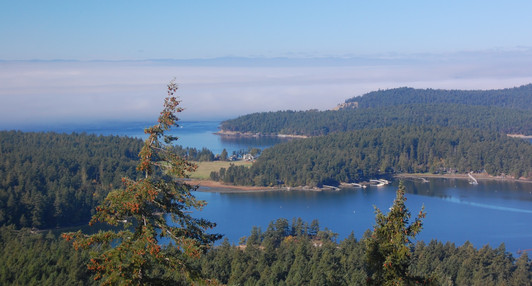Orcas, Porpoises, and Paddles: A Weekend Kayak Escape in the San Juans
- Ruth Bergman

- Aug 6
- 4 min read
Slipping into Island Time
If you’re looking for a Pacific Northwest adventure that’s equal parts wild and family-friendly, a weekend in the San Juan Islands might be just the ticket. It was October 2014. Oren had a work trip to the University of Washington, so the three of us—Oren, Eitan (16 at the time), and I—were already in Seattle. We decided to turn the weekend into an adventure, and just a couple hours' drive north brought us to Anacortes, where the car ferry to San Juan Island awaited.
It was Eitan’s first time on a car ferry, and watching his reaction to driving directly onto the boat was priceless—equal parts awe and disbelief. As the ferry pulled away from the mainland, we found ourselves slipping into a slower rhythm. The route wound its way through a maze of islands, some with only a house or two perched near the shoreline, others untouched and densely forested.
By the time we arrived in Friday Harbor, the shift was complete. The air was saltier, the pace gentler, and the vacation feeling immediate. We were ready to trade pavement for paddles.
Into the Water: Two Days by Kayak
We hadn’t been in a kayak since our trip to Glacier Bay in 2001, and Eitan had never been in one at all. So when we signed up for the Two-Day San Juan Island Kayaking Tour, we were excited—and slightly uncertain. We were ready for wildlife, but were we ready for cold Pacific water and two full days of paddling?
Turns out, this was exactly the right trip. It was billed as beginner-friendly, with no age limit and stable double kayaks—which I usually avoid now, but they were all I could handle back then. The experience was made even better by our guide, a marine biologist who could identify every creature we passed—from seabirds to moon jellies to the massive kelp forests swaying below us. She wove ecology into the rhythm of the paddle, teaching us as we moved through the islands.
Not long after leaving Friday Harbor, she pointed out a cluster of fishing boats. One of them had just brought up a large salmon. “Let’s keep an eye out,” she said. “If the salmon are here, the orcas may be too.” That was why we were here—hoping to spot the local resident pods.
Minutes later, she had us raft up tightly at the edge of the channel. Then we saw it: a tall, dark dorsal fin slicing the surface. Then another. A mother and calf. Then more—an entire pod of orcas gliding by. One breached with a splash, and I could hardly believe what I was seeing. It was like the whole sea paused to let them pass.
We didn’t see orcas again during those two days, but the magic of that encounter lingered. The rest of the paddle offered its own kind of wonder: seals watching us from rocky outcrops, sea stars clinging to low-tide shores, the gentle hush of our kayaks gliding through the water. We camped on Posey Island, hopping from one tiny isle to the next, fully immersed in this quiet, wild world.
Whale Watching: High Hopes and Hidden Hazards
After our close encounter with the orca pod from the kayaks, we were hooked. Could we see them again? With high hopes and cameras ready, we boarded a whale watching boat the next day, scanning the horizon for dorsal fins.
But nature has her own plans—and no interest in meeting human expectations. The orcas were nowhere to be found. For hours, the radio crackled with chatter between captains, each reporting silence or empty seas. Still, nature doesn’t disappoint. Eventually, we found a humpback whale, surfacing in a steady rhythm: three breaths, then a graceful tail flick and a dive into the deep. Then the wait. All of us scanning the water, guessing where it might appear next.
As we played this slow-motion game of hide and seek, a fog bank rolled in. Visibility dropped. We strained to see the whale. And then, instead, we saw something much bigger—looming right in front of us. A Canadian naval ship, its massive hull emerging from the mist, foghorn blaring. My heart skipped a beat. We were lucky not to have crashed into the ship.
The drama faded on our return trip, but the sea had one more surprise. A pod of playful porpoises discovered our boat and began leaping through the wake. The captain encouraged them, speeding up and curving the boat to give them more waves to ride. It was a joyful end to a day full of wild moments—just not the ones we’d expected.
Family Adventure, Perfectly Sized
The San Juan Islands are a gem—teeming with wildlife, surrounded by calm waters, and remarkably easy to reach from Seattle. For us, this short trip packed in everything: adventure, nature, and time together as a family. And for me, it was the first time seeing orcas in the wild. Watching those towering dorsal fins rise from the sea, seeing the pod travel together, each member tuned in to the others—it was one of the most majestic sights I’ve ever witnessed.
That memory stayed with me, not just because of its beauty, but because of its fragility. The resident orca population in the San Juan Islands is struggling, with declining numbers and low calf survival rates. Their future isn’t guaranteed. Getting out there, witnessing them firsthand, and supporting their preservation has never felt more important.
This trip also reignited something personal. With Ayelet and Eitan growing up and becoming more independent, we were starting to rediscover our own interests again. When we returned to Israel, we found a local kayaking club—Optimist Kayak—and finally took the time to really learn to paddle. It all started here, in the waters around San Juan Island, where the sea was quiet, the porpoises playful, and the orcas unforgettable.
Resources
Sea Quest Kayak https://sea-quest-kayak.com/kayaking-san-juan-islands/2-day-san-juan-kayaking-tours/
Washington State Department of Transportation https://wsdot.com/ferries/schedule/scheduledetailbyroute.aspx?route=ana-sj























Comments